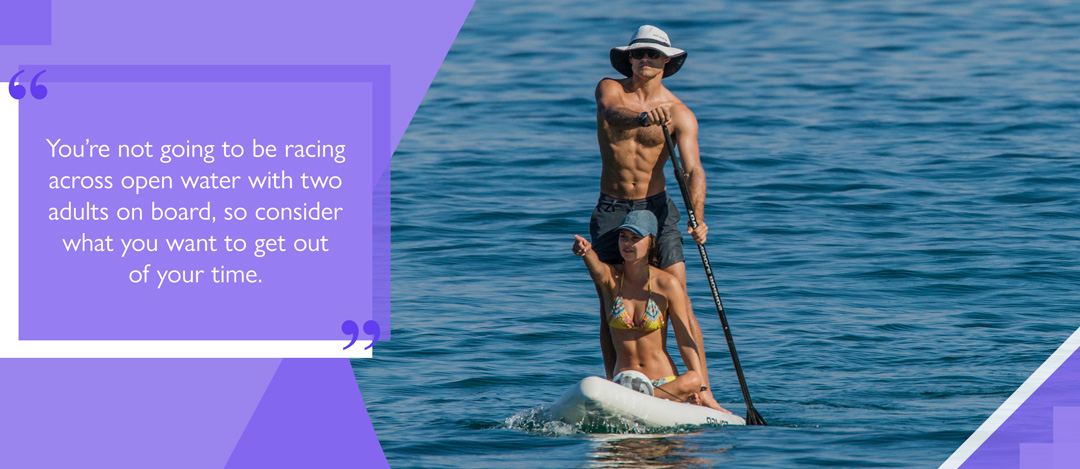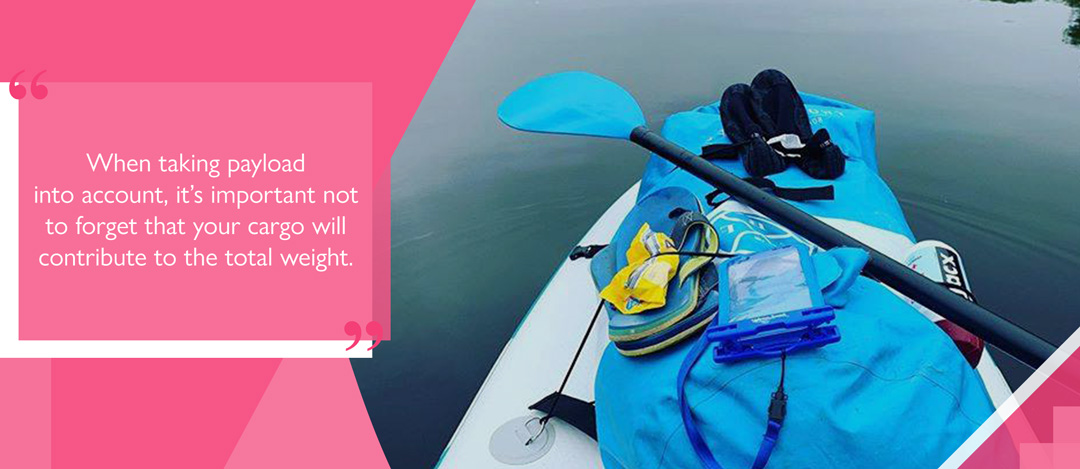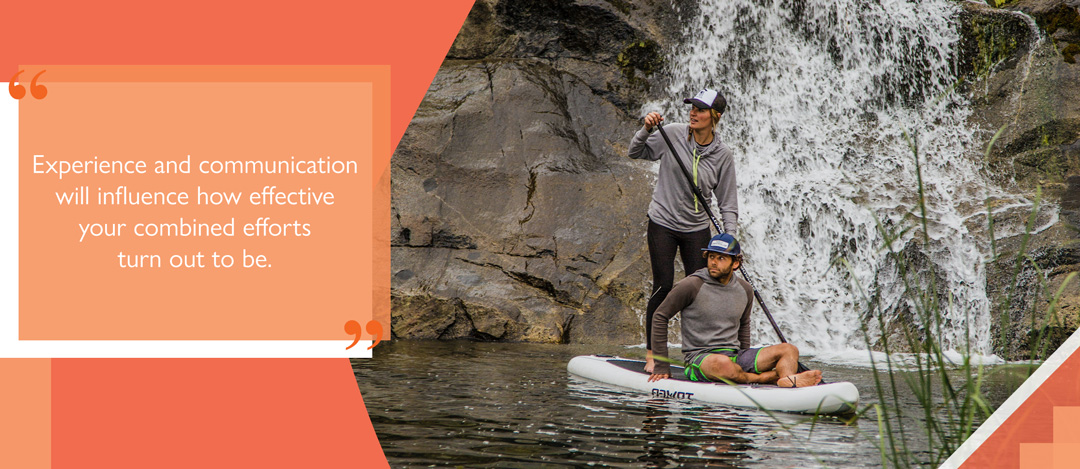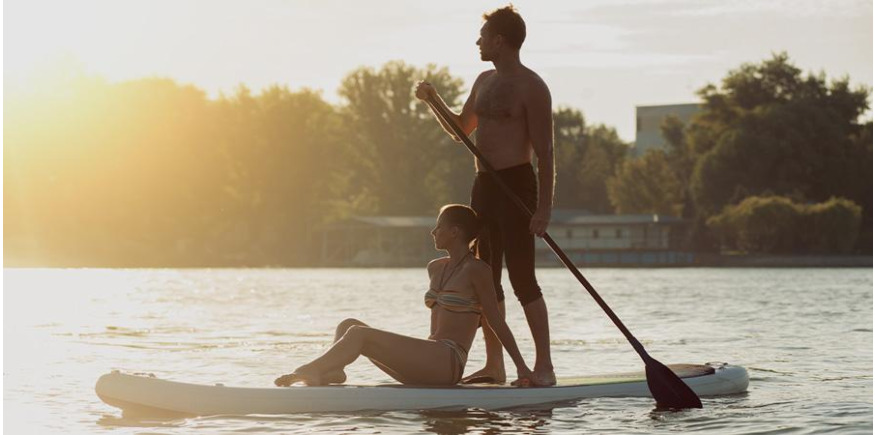One of the greatest attractions to stand-up paddle boarding is the ability to escape from the stresses of the world. If you go out on your own, the feeling of solitude can be refreshing.
Paddleboarding with a second person on your board can be a fun experience. While it is feasible, there will be some differences regular paddlers will need to consider.
Meeting your expectations
The physics involved with two people on a board can be noticeably different: you’ll move more slowly, extra effort will be required in paddling strokes, and how the board sits in the water may change due to the concentration of extra weight.
This means you’ll need to amend your expectations. You’re not going to be racing across open water with two adults on board, so consider what you want to get out of your time.
If you head out with the intention of relaxing, and don’t expect to be going on long river tours or riding waves, you won’t be disappointed.
What you get out of riding double often comes down to the situation. For example, it’s a great way to introduce a small child to SUP, as you’ll be on-hand to provide guidance and reassurance. However, a confident and independently minded older child may find the experience frustrating.

Choosing a board for two
Unless you own a larger or specialised oversize board, paddling with a second person can often mean opting for a large paddle board.
The board will need to cope with the additional mass, which means stability, balance and buoyancy are all going to be impacted. For some smaller boards, designed to perform optimally with a single rider, this may simply not be possible.
Ideally, you’ll want to go for a board with dimensions larger than a typical allrounder. Volume is key for staying stable and sitting on the water, so something longer or wider (or both) with sufficient depth (typically at least 6 inches) will help. A touring-class SUP is a good option.
Most good quality iSUPs will be constructed using drop-stitch technology, which helps to keep a board rigid. With excessive load, the framework could begin to strain, so a reinforced construction becomes even more important. Construction methods such as double-walled fusion (DWF) or the inclusion of an additional air chamber can provide the additional reassurance you want.
While some boards may not come with the option to alter fin configuration, getting a board with a three-fin (one central, two side fin) layout may also help provide added lateral stability to your ride.
Managing balance and weight
The weight capacity and distribution across the board is going to be an important part of riding in tandem. If the weight limit is exceeded, performance will take a hit and the board may behave erratically, or even sink beneath the waterline.
Be sure to check the SUP manufacturer’s guidance on maximum payloads, and ensure your combined weight does not exceed this.
In addition, make sure weight is spread across the board sufficiently, so that the SUP maintains its equilibrium. If both riders are positioned towards the tail, the rear of the board may dip into the water. Likewise, if an adult passenger is perched near the nose, the front could be submerged.

Bear in mind also that with two centres of gravity aboard, stability may shift awkwardly if people change positions on deck. It may be worth considering whether your passenger needs to be active — they could simply sit near the centre of the deck, while you paddle and, at some point, switch roles if preferred.
When taking payload into account, it’s important not to forget that your cargo will contribute to the total weight. Be conscious of what accessories or other items you want to bring, and how these are also distributed across your board. If you have two cargo nets, consider spreading the load between these.
The effect of weight on board motion
Riding with an additional adult is almost certainly going to lead to additional forces acting on the board that inhibit manoeuvrability. Drag will be the most noticeable: the SUP is not going to move quickly through the water, and any manoeuvres will require focus and effort.
To an extent, the problem can be offset by bringing an additional SUP paddle and having the second person add to the paddling output. However, experience and communication will influence how effective your combined efforts turn out to be. Your strokes, technique and intention will need to be synchronised.
If you or your passenger are not experienced paddlers, this could result in uncoordinated motion and effort. If you think this may likely be an issue, leave the paddling up to one person and enjoy the leisurely pace.

Staying safe together
It also goes without saying that impaired motion on the water is a risk factor, so if you do want to go out with someone else on your board, be sensible and stick to waters and conditions that will be conducive to you relaxing and having fun. Waves, rapids, and strong winds could be a bad idea.
Finally, as with any ride, make sure you are properly equipped with appropriate safety gear. Ensure both riders are attached to the board with a SUP leash of appropriate length, and make sure you both wear a PFD.
If you’d like more ideas on how to spend your quality time out on the water, our blog contains a variety of starting points to begin planning your adventures.
Trying to arrange a SUP excursion? Check out our post on planning a SUP trip . You may also want to have a look at our guide to paddleboarding holidays if you’re looking to get your feet wet while travelling to new places.




